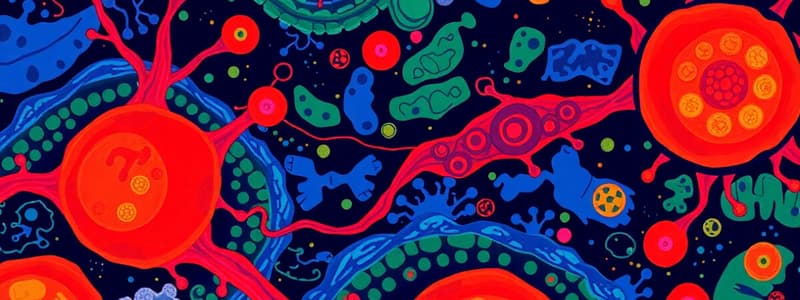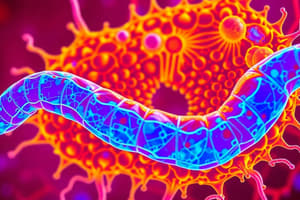Podcast
Questions and Answers
Which primary function is characteristic of non-membranous organelles?
Which primary function is characteristic of non-membranous organelles?
- Concentrating enzymes and reactants for increased efficiency
- Synthesizing proteins for export from the cell
- Providing structural support and organization within the cell (correct)
- Isolating harmful molecules from the cytoplasm
What is the main role of the membrane surrounding certain organelles?
What is the main role of the membrane surrounding certain organelles?
- To facilitate direct interaction between the organelle's enzymes and cellular proteins
- To separate the internal environment of the organelle from the external environment thereby increasing efficiency and isolating harmful substances (correct)
- To decrease the presence of enzymes and reactants inside the cell
- To allow free movement of all molecules into and out of the organelle
If a cellular process required the action of enzymes and concentration of reactants, what cellular component would primarily be responsible?
If a cellular process required the action of enzymes and concentration of reactants, what cellular component would primarily be responsible?
- Non-membranous organelles
- The cytosol itself
- Membrane-bound organelles (correct)
- Inclusions within the cell
How does the presence of membrane-bound organelles affect the biochemical efficiency of a cell?
How does the presence of membrane-bound organelles affect the biochemical efficiency of a cell?
Which of the following best describes the relationship between the nucleus and cytoplasm?
Which of the following best describes the relationship between the nucleus and cytoplasm?
In which part of the cell would you primarily find inclusions?
In which part of the cell would you primarily find inclusions?
A researcher identifies a cell component made up of specific macromolecules and organized to carry out complex functions, what is their description?
A researcher identifies a cell component made up of specific macromolecules and organized to carry out complex functions, what is their description?
Which modification of a protein is essential for cell viability and is characterized by the attachment of glycans?
Which modification of a protein is essential for cell viability and is characterized by the attachment of glycans?
Where in a eukaryotic cell does the majority of post-translational protein modification initially occur?
Where in a eukaryotic cell does the majority of post-translational protein modification initially occur?
What is the primary structural difference between N-linked and O-linked glycosylation?
What is the primary structural difference between N-linked and O-linked glycosylation?
In light microscopy (LM), what characteristic visual aspect does the Golgi apparatus exhibit in protein-producing cells like plasma cells?
In light microscopy (LM), what characteristic visual aspect does the Golgi apparatus exhibit in protein-producing cells like plasma cells?
Which of the following best describes the functional difference between the 'cis' and 'trans' faces of the Golgi complex?
Which of the following best describes the functional difference between the 'cis' and 'trans' faces of the Golgi complex?
Which of the following is NOT a component of the cytosol?
Which of the following is NOT a component of the cytosol?
What is a primary function of the cytoskeleton within the cytosol?
What is a primary function of the cytoskeleton within the cytosol?
Which of the following best describes the function of inclusions found in the cytosol?
Which of the following best describes the function of inclusions found in the cytosol?
Which of the following is characterized as a double membrane-bound organelle that provides energy to the cell?
Which of the following is characterized as a double membrane-bound organelle that provides energy to the cell?
In which of the following cell types would mitochondria likely be the LEAST abundant?
In which of the following cell types would mitochondria likely be the LEAST abundant?
What is the general size range for mitochondria based on width and length?
What is the general size range for mitochondria based on width and length?
Which of the following best describes the lifespan of a typical mitochondrion?
Which of the following best describes the lifespan of a typical mitochondrion?
Which of the following is a non-membranous organelle?
Which of the following is a non-membranous organelle?
The presence of which of the following would indicate the cell has high metabolic demands?
The presence of which of the following would indicate the cell has high metabolic demands?
Which enzyme, when released into the cytoplasm, directly triggers programmed cell death?
Which enzyme, when released into the cytoplasm, directly triggers programmed cell death?
The mitochondrial matrix does not contain which of the following?
The mitochondrial matrix does not contain which of the following?
What is the primary function of the electron-dense matrix granules found within mitochondria?
What is the primary function of the electron-dense matrix granules found within mitochondria?
Which type of cells are most likely to contain tubulo-vesicular cristae?
Which type of cells are most likely to contain tubulo-vesicular cristae?
Which of the following mitochondrial processes is NOT directly involved in ATP production?
Which of the following mitochondrial processes is NOT directly involved in ATP production?
What is the primary source for the majority of proteins found in the mitochondria?
What is the primary source for the majority of proteins found in the mitochondria?
What are translocases responsible for in the context of mitochondria?
What are translocases responsible for in the context of mitochondria?
Which of these enzymes is located in the intermembrane space of the mitochondria?
Which of these enzymes is located in the intermembrane space of the mitochondria?
What is the direct role of caspases in the cell?
What is the direct role of caspases in the cell?
What is the significance of the two types of cristae morphology in mitochondria?
What is the significance of the two types of cristae morphology in mitochondria?
What is the primary function of translocases in mitochondria?
What is the primary function of translocases in mitochondria?
Which of the following best describes the structural organization of the endoplasmic reticulum (ER)?
Which of the following best describes the structural organization of the endoplasmic reticulum (ER)?
What is the distinguishing feature that differentiates the rough ER from the smooth ER?
What is the distinguishing feature that differentiates the rough ER from the smooth ER?
What term describes the flattened, membrane-limited sacs that are characteristic of the rough ER?
What term describes the flattened, membrane-limited sacs that are characteristic of the rough ER?
What is one of the primary functions associated with the rough endoplasmic reticulum (rER)?
What is one of the primary functions associated with the rough endoplasmic reticulum (rER)?
What components are ribosomes, which are found on the rough ER, made of?
What components are ribosomes, which are found on the rough ER, made of?
Which of the following is a post-translational modification that occurs in the rER?
Which of the following is a post-translational modification that occurs in the rER?
What is the critical consequence of improper protein folding?
What is the critical consequence of improper protein folding?
What type of interactions stabilize the three-dimensional structure of proteins?
What type of interactions stabilize the three-dimensional structure of proteins?
What is the role of protein folding?
What is the role of protein folding?
Flashcards
Cytoplasm
Cytoplasm
The substance within a cell, excluding the nucleus, that contains organelles, cytosol, and inclusions.
Organelles
Organelles
Highly organized structures within a cell that carry out specific functions.
Membranous Organelle
Membranous Organelle
A membranous compartment within a cell that separates its internal environment from the cytoplasm. These compartments concentrate enzymes and reactants, increase biochemical efficiency, and isolate harmful molecules.
Non-membranous Organelle
Non-membranous Organelle
Signup and view all the flashcards
Cytosol
Cytosol
Signup and view all the flashcards
Inclusions
Inclusions
Signup and view all the flashcards
Nucleus
Nucleus
Signup and view all the flashcards
What is cytosol?
What is cytosol?
Signup and view all the flashcards
What is the cytoskeleton?
What is the cytoskeleton?
Signup and view all the flashcards
What are inclusions?
What are inclusions?
Signup and view all the flashcards
What are mitochondria?
What are mitochondria?
Signup and view all the flashcards
Where are mitochondria abundant?
Where are mitochondria abundant?
Signup and view all the flashcards
Where are mitochondria absent?
Where are mitochondria absent?
Signup and view all the flashcards
What is the lifespan of mitochondria?
What is the lifespan of mitochondria?
Signup and view all the flashcards
Describe the structure of mitochondria.
Describe the structure of mitochondria.
Signup and view all the flashcards
What is the staining property of mitochondria?
What is the staining property of mitochondria?
Signup and view all the flashcards
Glycosylation
Glycosylation
Signup and view all the flashcards
Bound polysomes
Bound polysomes
Signup and view all the flashcards
Golgi cis face
Golgi cis face
Signup and view all the flashcards
Golgi trans face
Golgi trans face
Signup and view all the flashcards
Golgi staining in LM
Golgi staining in LM
Signup and view all the flashcards
Intermembrane Space
Intermembrane Space
Signup and view all the flashcards
Creatine Kinase (CK)
Creatine Kinase (CK)
Signup and view all the flashcards
Adenylate Kinase
Adenylate Kinase
Signup and view all the flashcards
Cytochrome C
Cytochrome C
Signup and view all the flashcards
Apoptosis
Apoptosis
Signup and view all the flashcards
Caspase
Caspase
Signup and view all the flashcards
Mitochondrial Matrix
Mitochondrial Matrix
Signup and view all the flashcards
Mitochondrial DNA
Mitochondrial DNA
Signup and view all the flashcards
Cristae
Cristae
Signup and view all the flashcards
Oxidative Phosphorylation
Oxidative Phosphorylation
Signup and view all the flashcards
What are translocases and why are they important?
What are translocases and why are they important?
Signup and view all the flashcards
What are TOM and TIM?
What are TOM and TIM?
Signup and view all the flashcards
What is the Endoplasmic Reticulum?
What is the Endoplasmic Reticulum?
Signup and view all the flashcards
What is the Rough Endoplasmic Reticulum (rER)?
What is the Rough Endoplasmic Reticulum (rER)?
Signup and view all the flashcards
What is the Smooth Endoplasmic Reticulum (sER)?
What is the Smooth Endoplasmic Reticulum (sER)?
Signup and view all the flashcards
What are cisternae?
What are cisternae?
Signup and view all the flashcards
What are ribosomes?
What are ribosomes?
Signup and view all the flashcards
What are the main functions of the Rough Endoplasmic Reticulum (rER)?
What are the main functions of the Rough Endoplasmic Reticulum (rER)?
Signup and view all the flashcards
What is protein folding?
What is protein folding?
Signup and view all the flashcards
Why is protein folding important?
Why is protein folding important?
Signup and view all the flashcards
Study Notes
Cell Organelles
- Cellular components are divided into nucleus and cytoplasm
- Cytoplasm contains organelles and cytosol
- Organelles are complexes of macromolecules, carrying out specific functions, some are membrane-bound and others are not
- Membrane-bound organelles concentrate enzymes and reactants, increase biochemical efficiency and isolate harmful proteins and molecules from the rest of the cell
- Non-membranous organelles include microtubules, centrioles, and nucleoli
- Cytosol is a gel-like substance containing dissolved macromolecules, organic compounds & ions, cytoskeleton (microtubules, actin filaments and intermediate filaments), which organizes organelles and provides mechanical support. Also contains inclusions—products of metabolic activity and insoluble substances, such as glycogen, lipid droplets, lipofuscin, hemosiderin, and crystals
Learning Objectives
- Describe location, function and staining characteristics of cytoplasmic organelles
- Differentiate between membrane-bound organelles (rough ER, smooth ER, Golgi complex, mitochondria, lysosomes, and peroxisomes) and explain their functions
- Differentiate between free polyribosomes and membrane-bound polyribosomes and identify their roles in protein sorting
- Determine the trafficking of different classes of protein to their destination
- Describe autophagy and cytoplasmic protein degradation
- Explain how faulty protein degradation leads to Alzheimer's disease
- Describe proteasome-mediated protein degradation
- Describe the functions of peroxisomes
- Identify all cell organelles in a given electron micrograph, indicating the cell types in which they are abundant
Mitochondria
- Double membrane-bound organelle
- Provides energy to the cell (generating & expending energy) abundant in heart muscle, liver cells, and some kidney cells
- Absent in erythrocytes and terminal keratinocytes/corneocytes
- Spherical or filamentous, acidophilic structures (0.5-1µm wide and 10µm long)
- Constantly turning over, lifespan of 1-10 days (varies)
Mitochondria Structure
- Possesses two membranes separated by intermembrane space
- Outer membrane contains large channels (e.g., porins), permits ions & small molecules to enter the intermembrane space.
- Inner membrane is impermeable to ions but projects into the matrix to form numerous folds (cristae), increasing the surface area, and is responsible for oxidative phosphorylation and ATP synthesis
- Attached to the inner membrane are ATP synthase particles (elementary particles)
- Matrix contains soluble enzymes of the Krebs cycle, enzymes for fatty acid oxidation, electron-dense matrix granules that store Ca++, mitochondrial DNA, ribosomes and tRNA
Mitochondria cont. (Intermembrane Space)
- Contains specific enzymes: creatine kinase, adenylate kinase, and cytochrome C.
- When cytochrome C is discharged into the cytoplasm, it initiates apoptosis (programmes cell death)
- Cytochrome C activates caspase, a key enzyme in cell death or apoptosis
Mitochondria cont. (Matrix)
- Surrounded by the inner membrane
- Contains soluble enzymes of the Krebs cycle and enzymes for fatty acid oxidation; electron dense matrix granules store Ca++ and mitochondrial DNA, ribosomes and tRNA
Mitochondria cont. (Cristae)
- Two types of cristae: tubular or vesicular and plate-like
- Most cells contain mitochondria with plate-like cristae. Steroid hormone-secreting cells (e.g., adrenal cortex cells, gonadal cells) have tubulo-vesicular cristae
Mitochondrial Enzymes System
- Responsible for ATP generation in various metabolic pathways (oxidative phosphorylation, citric acid cycle, beta oxidation of fatty acids)
- Mitochondrial DNA synthesizes only 1% of mitochondrial proteins
- The remaining proteins are synthesized by free ribosomes in the cytoplasm and transported into the mitochondrial matrix through protein complexes called translocases (TOM and TIM)
- Absence of translocases affects mitochondrial functions
Endoplasmic Reticulum (ER)
- Mesh-like interconnected maze of branching tubes and flattened lamellae (cisternae)
- Two types: rough (rER) and smooth (sER)
- Rough ER: ribosomes attach to the outer surface and is involved in protein synthesis, post-translational modification, proper protein folding and initial glycosylation.
- Smooth ER: outer surface ribosomes-free, involved in synthesis of steroid hormones, membrane lipids, breakdown of toxins & drugs, detoxification, synthesis of triglycerides from monoglycerides in intestinal epithelium, and calcium sequestration in striated muscle (sarcoplasmic reticulum)
Ribosomes
- In the cytosol, ribosomes are connected by a strand of mRNA (polysomes)
- Found in two forms: free polysomes (free in the cytosol) and bound polysomes (attached to the outer surface of rER cisternae)
- Synthesize different classes of proteins
- Ribosomes are responsible for cytoplasmic basophilia in Light Microscopy (LM)
Golgi Complex (Apparatus)
- Group of flattened sacs with vesicles around the margins.
- From one to hundreds in a cell, depending on the cell type.
- Prominent in protein-secreting cells.
- At the transmission electron microscopy (TEM) level, it appears to consist of three defined regions: cis, medial, and trans.
Golgi Complex cont.
- Cis face: receiving/forming/entry face; substances enter from the endoplasmic reticulum for processing
- Trans face: exit face; matured proteins exit in the form of small detached vesicles.
- Involved in concentrating and maturing proteins. The process of protein maturation involves movement through the cis, medial, and trans regions. Each region has its unique enzymes involved in protein maturation. Mature proteins are then secreted in vesicles.
Golgi Complex functions
- Posttranslational modifications of proteins (O-glycosylation)
- Sorting and packaging of proteins
Lysosomes
- Membrane-bound organelles containing around 40 different types of enzymes working in an acidic pH.
- They contain acid hydrolases, inactive in the cytosol if they leak out (cytosol pH is 7.2).
- Sites of intracellular digestion and turnover of cellular components.
- Found in all cell types, abundant in phagocytic cells (e.g., neutrophils and macrophages)
Biogenesis of Lysosomes
- Lysosomal enzymes synthesised in rER, modified, sorted and packaged in Golgi
- Mannose-6-phosphate added to lysosomal enzymes in Golgi
- Material for degradation brought to lysosomes by heterophagy (endocytosis & phagocytosis) and autophagy (degradation of cell’s senescent organelles and large denatured proteins)
- Degraded materials either released into cytoplasm or removed by exocytosis
Lysosomes degrade cytoplasmic proteins and organelles via autophagy
- Three autophagic pathways: macroautophagy, microautophagy, and chaperone-mediated autophagy.
Residual Bodies
- Digested materials inside lysosomes are recycled or released to the outside.
- Indigestible compounds stored are called residual bodies.
- Appear as yellowish brown pigments around the nucleus (lipofuscins).
- The unreleased indigestible compounds in long-living cells are called aging pigments; present in neurons and cardiac muscle cells
Lysosomal Storage Diseases
- Absence of certain lysosomal enzymes leads to lysosomal storage diseases which is a pathological condition.
- Caused by mutations in genes encoding lysosomal proteins.
- Results in accumulation of undigested products.
- Examples include Tay-Sachs disease (absence of lysosomal galactosidase), and Gaucher's disease/ Pompe disease (lack of enzyme that breaks down glycolipids / lack of acid maltase).
Peroxisomes (Microbodies)
- Membrane-bound spherical or slightly ovoid structures (0.3-1.5 µm)
- Regulate hydrogen peroxide levels in cells and contain catalase enzymes that break down hydrogen peroxide.
- Involved in beta-oxidation of long-chain fatty acids, formation of bile acids and cholesterol. Synthesizes plasmalogen in nerve cells.
- Abundant in liver cells (hepatocytes).
- Peroxisomes differ from lysosomes in their self-replicating ability.
Peroxisome malfunction (Zellweger Syndrome)
- Leads to over-accumulation of very long-chain fatty acids, affecting brain (hypotonia), liver (jaundice) and kidneys (polycystic kidney disease).
- An example of a peroxisome-related disorder.
Proteasome-Mediated Protein Degradation
- Lysosomes are not involved, but proteasomes are
- Proteins must be tagged by ubiquitin.
- Used by cells to destroy abnormal proteins (e.g., misfolded, denatured, or abnormal), cell cycle progression proteins (e.g., cyclins, transcription factors), and tumor suppressors/tumor progressors.
- Protein degradation malfunction can lead to decreased protein degradation in some diseases (e.g., Alzheimer's and Angelman syndrome) or accelerated protein degradation in certain conditions (e.g. human papillomavirus infection).
Other Topics
- Includes a summary of Golgi complex functions
- Includes a summary of smooth ER functions
- Includes pictures of various organelles, cell types and tissues
Studying That Suits You
Use AI to generate personalized quizzes and flashcards to suit your learning preferences.




